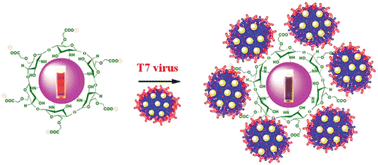T7 bacteriophage induced changes of gold nanoparticle morphology: biopolymer capped gold nanoparticles as versatile probes for sensitive plasmonic biosensors
Abstract
The morphological changes of gold nanoparticles induced by T7 virus (bacteriophage) and the determination of its femtomolar concentration by a plasmonic method are presented. Carboxymethyl chitosan capped gold nanoparticles (CMC-AuNPs) are used as plasmonic probes and are synthesized by a simple one pot wet chemical method. HR-TEM images show that the spherical structure of the CMC-AuNPs is changed into chain-like nanostructures after the addition of T7 virus due to the strong coordination of CMC-AuNPs with T7. Since T7 capsids comprise a repeating motif of capsomers built from proteins that bind to the acid groups of chitosan, the conjugation of carboxymethyl chitosan-linked AuNPs with T7 virions enables colorimetric biosensing detection. The absorbance intensity (∼610 nm) increases in the concentration range of T7 from 2 × 10−15 M to 2 × 10−13 M and the detection limit is found to be 2 × 10−15 M (2 fM). The present work demonstrates eco-friendly biopolymer stabilized AuNPs as potential nanomaterials for biosensing of viruses. Our method is very simple, low cost, selective and highly sensitive, and provides new insight into virus induced chain-like morphology of AuNPs.


 Please wait while we load your content...
Please wait while we load your content...